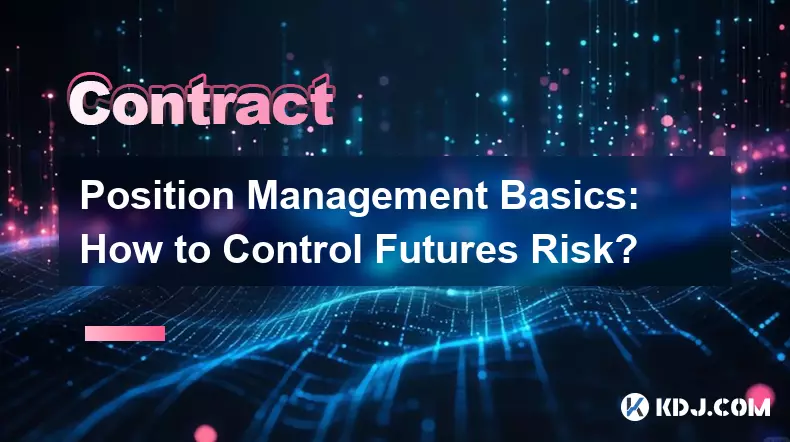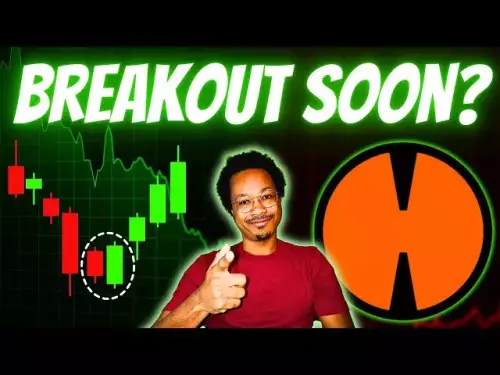-
 bitcoin
bitcoin $113137.862908 USD
0.65% -
 ethereum
ethereum $4107.436072 USD
-1.96% -
 xrp
xrp $2.908808 USD
2.59% -
 tether
tether $1.000294 USD
0.01% -
 bnb
bnb $1010.914842 USD
-1.12% -
 solana
solana $210.653310 USD
-2.16% -
 usd-coin
usd-coin $0.999776 USD
-0.01% -
 dogecoin
dogecoin $0.239360 USD
-0.04% -
 tron
tron $0.337849 USD
0.37% -
 cardano
cardano $0.807698 USD
-0.61% -
 hyperliquid
hyperliquid $45.387447 USD
0.61% -
 chainlink
chainlink $21.408287 USD
-0.92% -
 ethena-usde
ethena-usde $1.000509 USD
-0.04% -
 avalanche
avalanche $32.634682 USD
-4.77% -
 sui
sui $3.349772 USD
-0.19%
Position Management Basics: How to Control Futures Risk?
Proper position sizing, stop-loss placement, and conservative leverage are crucial in crypto futures trading to manage risk and avoid catastrophic drawdowns.
Sep 18, 2025 at 11:01 am

Understanding Position Sizing in Futures Trading
1. Determining the correct position size is fundamental when engaging in futures trading within the cryptocurrency market. Traders must assess their total capital and decide what percentage they are willing to risk on a single trade, typically ranging between 1% to 5%. This helps prevent significant drawdowns even during losing streaks.
2. Using fixed fractional methods allows traders to scale their positions according to account equity. For instance, if a trader has $10,000 and opts for a 2% risk per trade, only $200 should be at risk in any given setup, regardless of leverage availability.
3. Position size also depends on stop-loss placement. The closer the stop-loss is to the entry price, the larger the position can be while maintaining the same dollar risk. Conversely, wider stops require smaller sizes to preserve capital integrity.
4. Leverage amplifies both gains and losses, making it crucial to adjust position size accordingly. A highly leveraged trade with a large size may lead to liquidation even from minor adverse price movements.
5. Many experienced traders use volatility-based sizing models such as Average True Range (ATR) to dynamically adapt their exposure. High volatility environments call for reduced sizes to maintain consistent risk profiles.
Implementing Stop-Loss and Take-Profit Strategies
1. A well-placed stop-loss order acts as an automatic exit mechanism when the market moves against a trader beyond a predefined threshold. In fast-moving crypto futures markets, this prevents emotional decision-making during downturns.
2. Traders should avoid placing stop-loss orders at obvious technical levels where market makers might trigger them intentionally. Instead, using confluence zones or buffer margins around support/resistance increases resilience against stop hunts.
3. Take-profit levels should align with realistic reward-to-risk ratios, commonly set at 2:1 or higher. Setting multiple take-profit targets allows partial exits at different price points, locking in profits incrementally.
4. Trailing stop-losses are effective in capturing extended trends without prematurely exiting winning trades. These dynamic stops follow the price at a set distance, protecting profits during strong momentum moves.
5. Never disable stop-loss orders in pursuit of higher returns—this significantly increases exposure to catastrophic drawdowns, especially in volatile digital asset markets.
Leverage Management and Margin Monitoring
1. While exchanges offer up to 100x leverage on crypto futures, utilizing maximum leverage consistently is a recipe for rapid account depletion. Conservative leverage between 2x and 10x provides breathing room for price fluctuations.
2. High leverage reduces the margin buffer, increasing susceptibility to liquidation. Monitoring maintenance margin requirements and ensuring sufficient free collateral is available prevents unexpected forced closures.
3. Cross-margin versus isolated margin settings impact risk distribution. Isolated margin limits loss to a specific position’s allocated funds, while cross-margin uses the entire account balance, potentially endangering overall equity.
4. Real-time monitoring tools help track margin utilization rates. When utilization exceeds 70%, it signals elevated risk, prompting either reduction in position size or addition of funds to avoid liquidation under pressure.
5. Frequent assessment of open positions relative to current market volatility ensures that leverage remains appropriate and does not outpace risk tolerance.
Hedging Techniques in Crypto Futures Markets
1. Hedging involves opening offsetting positions to reduce directional exposure. For example, holding a long spot Bitcoin position while shorting BTC/USDT futures mitigates downside risk during bearish phases.
2. Correlation-based hedging uses related assets; for instance, shorting Ethereum futures to hedge a portfolio heavy in altcoins that often move in tandem with ETH.
3. Options can complement futures hedges by providing asymmetric protection. Buying put options on Bitcoin gives downside insurance without requiring active management of short futures.
4. Basis trading—exploiting price differences between spot and futures—can generate neutral returns while maintaining market exposure. This strategy works best during periods of contango or backwardation.
5. Effective hedging requires precise timing and cost evaluation, as funding fees and transaction costs can erode benefits if not carefully managed.
Frequently Asked Questions
What is the ideal risk percentage per futures trade?Most professional traders recommend risking no more than 1% to 2% of total trading capital per futures trade. This preserves longevity and allows recovery after losing streaks.
How do funding rates affect futures position management?Funding rates transfer value between long and short holders every 8 hours on many exchanges. Holding positions over extended periods incurs cumulative costs or gains depending on the rate's direction, influencing profitability.
Can I automate my stop-loss and take-profit levels?Yes, nearly all major crypto derivatives platforms support pre-set stop-loss and take-profit orders. These can be placed as part of conditional or OCO (One-Cancels-the-Other) orders for better control.
Why is over-leveraging dangerous even with proper stop-losses?Over-leveraging narrows the price range before liquidation occurs. Even with stop-losses, slippage during high volatility events may result in execution far below intended levels, leading to larger-than-expected losses.
Disclaimer:info@kdj.com
The information provided is not trading advice. kdj.com does not assume any responsibility for any investments made based on the information provided in this article. Cryptocurrencies are highly volatile and it is highly recommended that you invest with caution after thorough research!
If you believe that the content used on this website infringes your copyright, please contact us immediately (info@kdj.com) and we will delete it promptly.
- Coin Value Challenge: Navigating the Shifting Sands of Crypto and Tradition
- 2025-09-26 08:25:13
- XRP, Cardano, and Opportunity: Navigating the Crypto Landscape in 2025
- 2025-09-26 08:25:13
- Pepe, Price Prediction, and Returns: Is the Meme Magic Fading?
- 2025-09-26 08:45:14
- BullZilla: The Meme Coin Behemoth with 100x Potential?
- 2025-09-26 08:30:01
- Base's Blockchain Base: Developers Drive TVL Goal to $5 Billion and Beyond
- 2025-09-26 08:45:14
- MoonBull Presale: Your Ticket to the Next Pepe-Level Crypto Opportunity?
- 2025-09-26 08:30:01
Related knowledge

How do I enable the "scalping-only" mode for Cardano (ADA) contracts?
Sep 24,2025 at 03:19am
Understanding Scalping Strategies in Crypto Derivatives1. Scalping in cryptocurrency trading refers to executing multiple short-term trades within min...

What is the maximum position limit for Cardano (ADA) contracts?
Sep 23,2025 at 11:00pm
Understanding ADA Futures and Derivatives Market Structure1. Cardano (ADA) futures contracts are offered by several major cryptocurrency derivatives e...

What is the maker fee for Cardano (ADA) contracts?
Sep 26,2025 at 09:01am
Understanding Maker Fees in Cardano (ADA) Contracts1. The concept of maker fees applies broadly across decentralized exchanges and smart contract plat...

How can I view open interest in Cardano (ADA) contracts?
Sep 24,2025 at 07:36am
Understanding Open Interest in Cardano Derivatives1. Open interest refers to the total number of outstanding derivative contracts, such as futures or ...

What is the function of the insurance fund in Cardano (ADA) contracts?
Sep 24,2025 at 02:18am
Understanding the Role of Insurance Funds in Cardano Smart Contracts1. The insurance fund within Cardano's ecosystem is not a native feature directly ...

How can I view historical transaction records for Cardano (ADA) contracts?
Sep 24,2025 at 04:01pm
Understanding Cardano's On-Chain Data Structure1. Cardano operates on a proof-of-stake blockchain that records all transactions in blocks secured thro...

How do I enable the "scalping-only" mode for Cardano (ADA) contracts?
Sep 24,2025 at 03:19am
Understanding Scalping Strategies in Crypto Derivatives1. Scalping in cryptocurrency trading refers to executing multiple short-term trades within min...

What is the maximum position limit for Cardano (ADA) contracts?
Sep 23,2025 at 11:00pm
Understanding ADA Futures and Derivatives Market Structure1. Cardano (ADA) futures contracts are offered by several major cryptocurrency derivatives e...

What is the maker fee for Cardano (ADA) contracts?
Sep 26,2025 at 09:01am
Understanding Maker Fees in Cardano (ADA) Contracts1. The concept of maker fees applies broadly across decentralized exchanges and smart contract plat...

How can I view open interest in Cardano (ADA) contracts?
Sep 24,2025 at 07:36am
Understanding Open Interest in Cardano Derivatives1. Open interest refers to the total number of outstanding derivative contracts, such as futures or ...

What is the function of the insurance fund in Cardano (ADA) contracts?
Sep 24,2025 at 02:18am
Understanding the Role of Insurance Funds in Cardano Smart Contracts1. The insurance fund within Cardano's ecosystem is not a native feature directly ...

How can I view historical transaction records for Cardano (ADA) contracts?
Sep 24,2025 at 04:01pm
Understanding Cardano's On-Chain Data Structure1. Cardano operates on a proof-of-stake blockchain that records all transactions in blocks secured thro...
See all articles










































































